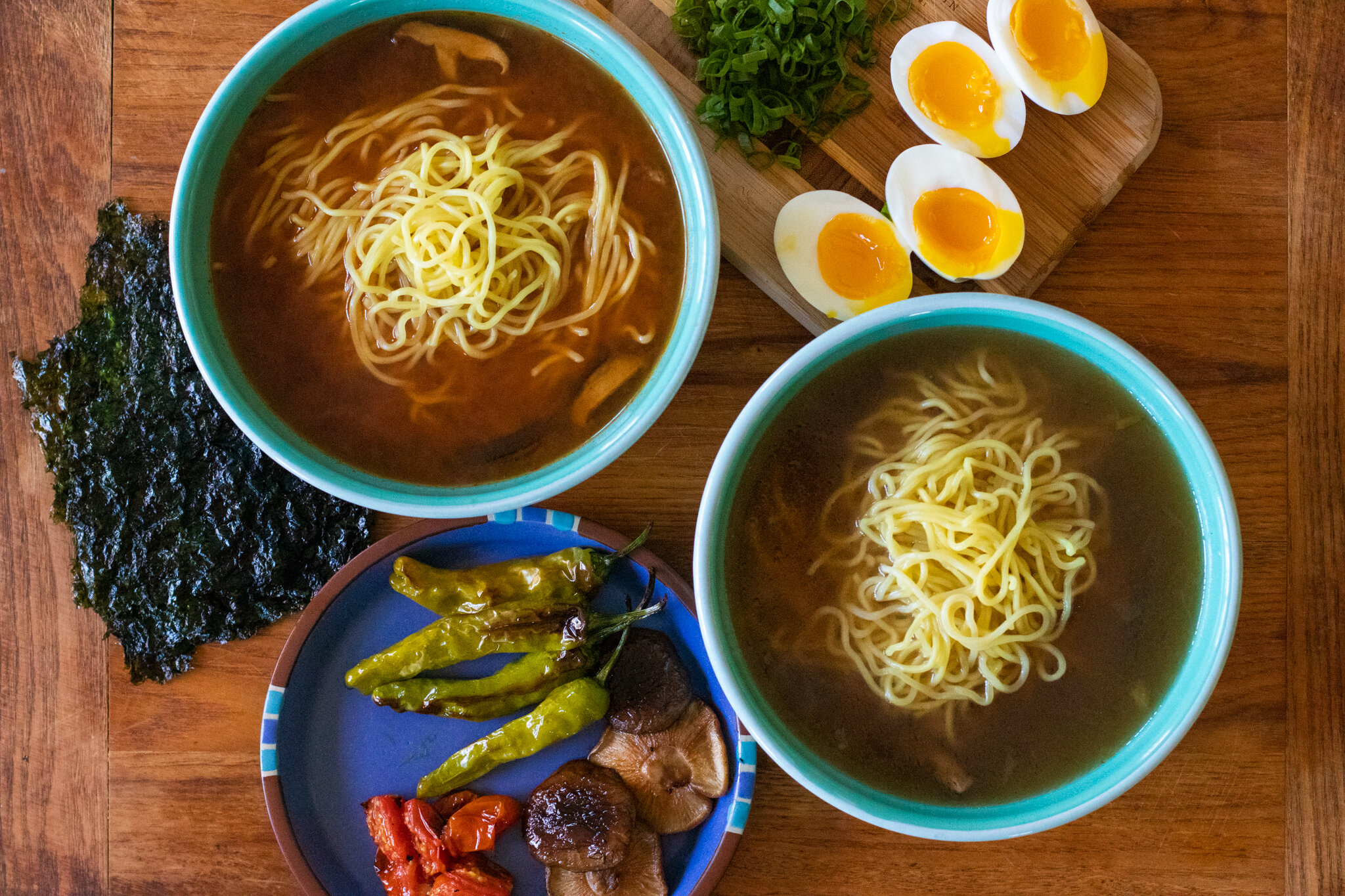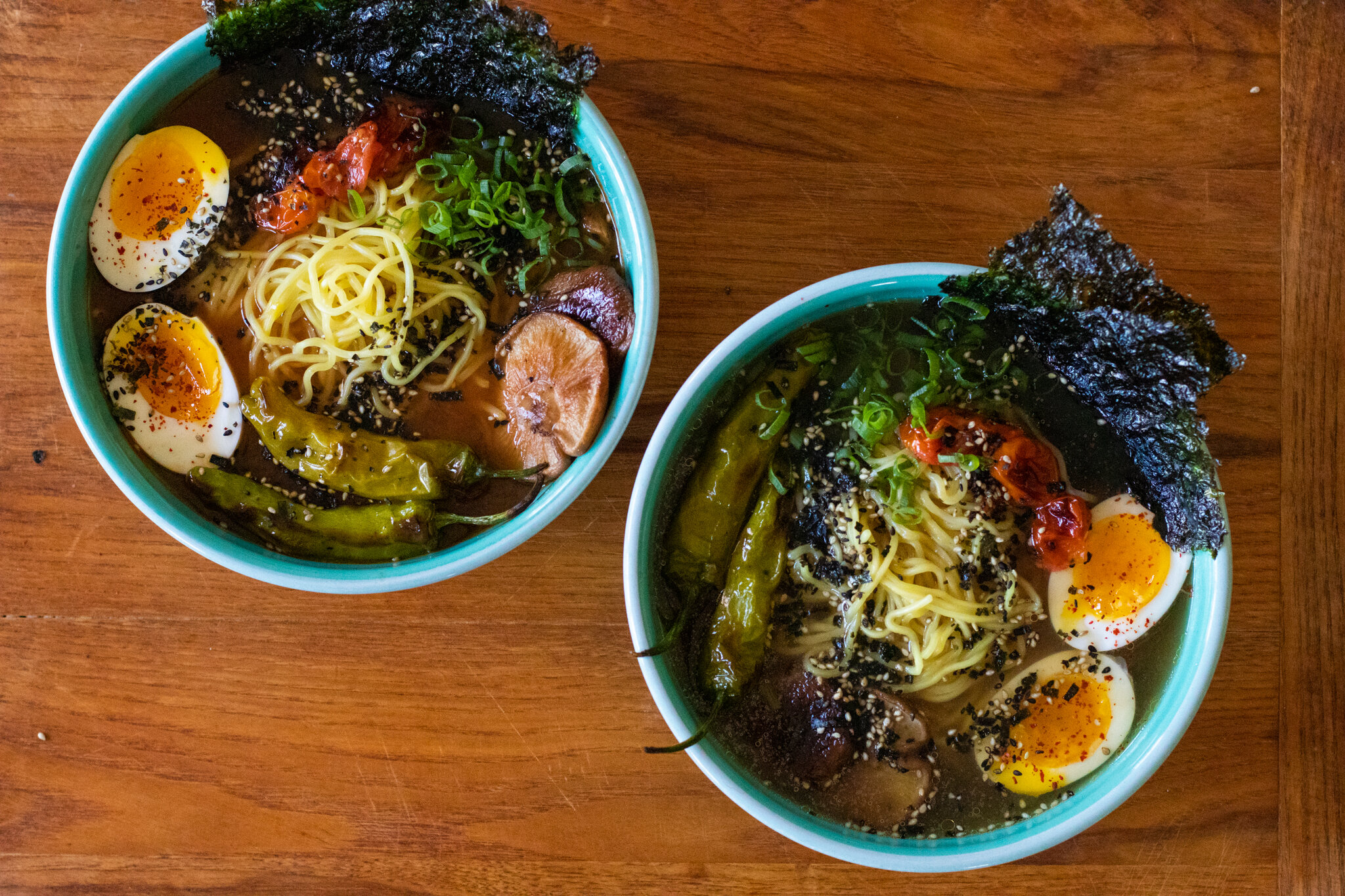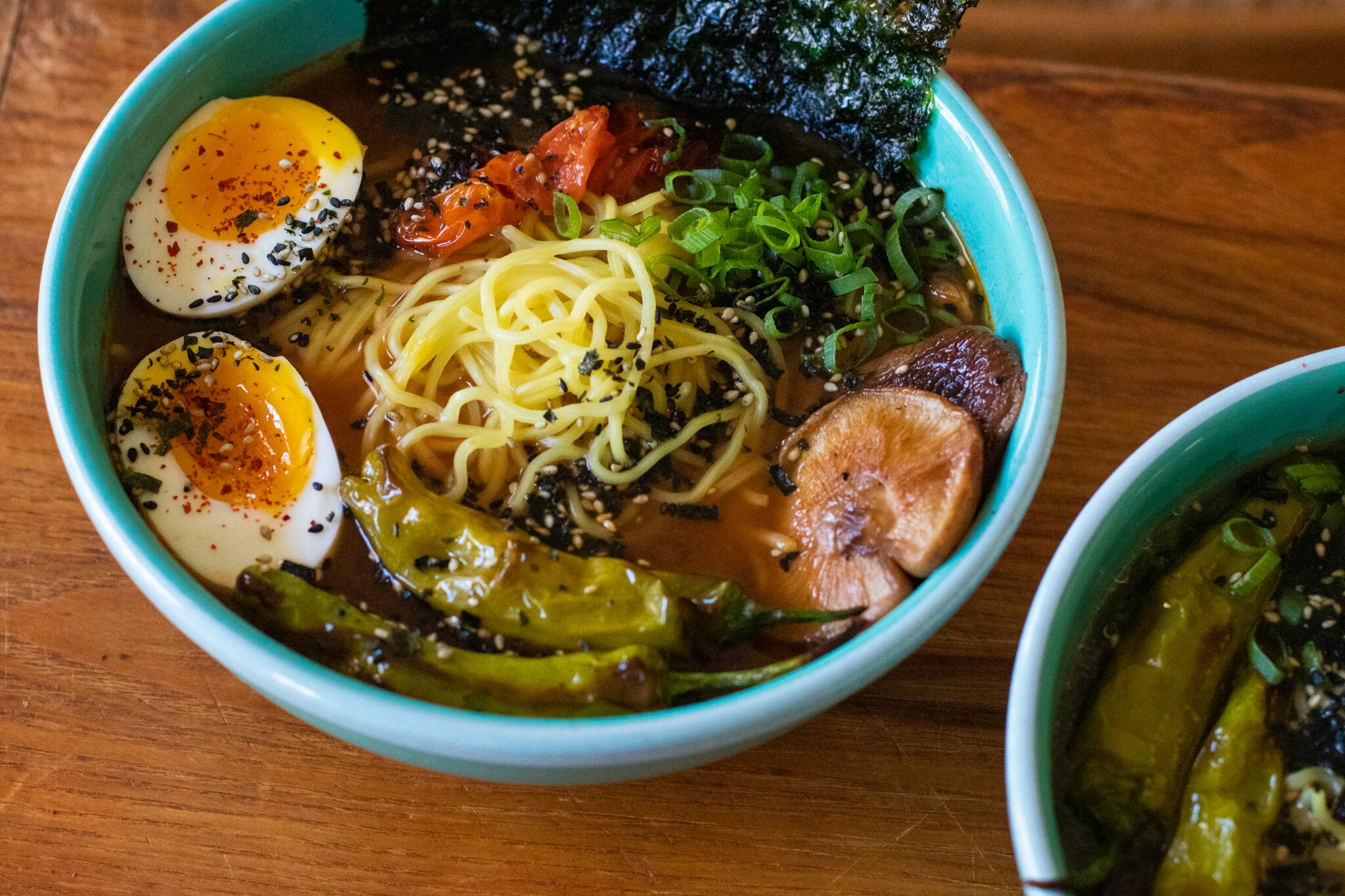Vegetarian Ramen
Never has a noodle soup garnered more universal praise and admiration than RAMEN! Well….maybe pho…but, one recipe at a time. I mean, what’s not to love? A rich, umami packed broth. Springy, slurpable noodles. A WORLD of garnish options. A satisfying, surprising, complex Japanese comfort food that keeps the world coming back for more.
While ramen has a reputation in the United States for being an extremely inexpensive food, reserved for microwaves and college dorms, traditional ramen is nuanced and full of complex flavors and has been crafted for centuries by culinary experts. Ramen also has a reputation for being particularly high in sodium, but that is often due to the ingredients used in the flavoring packets that accompany instant-ramen. Making your own ramen is an awesome way to have total control over both the symphony of flavors and the nutritional content.
Traditionally, the rich broth these noodles bathe in contains an animal-based stock of some type, and a small cut of meat. In an effort to make this dish a bit more sustainable and accessible for those with plant-based/focused diets, we’re sharing this vegetarian ramen recipe that hits every note! We’ve developed this recipe by utilizing a number of common culinary themes from Japanese chefs, and find it brings together some of our favorite elements from lots of different recipes. Grab a bowl, and check out the recipe below!
Ps. This recipe admittedly has many ingredients. Most of the ingredients for the broth are amazing additions to your pantry, or you may have them already. Many of the garnishes are certainly optional.
Ingredients
Makes: 2 servings
10 oz ramen noodles: we recommend fresh if possible! These can often be found in packages in Asian-Cuisine markets.
Broth Option 1 - Spicy Red Broth
1 sheet of Kombu: optional but heavily recommended
2 tbsp soy sauce
4 tsp tomato paste
4 tsp gochujang paste
2 tsp rice vinegar
4 Shitake mushrooms: sliced ¼” thick
2 scallions: thinly slice the whites. Reserve the dark green portion for garnish
5 cloves of garlic: peeled and coarsely chopped
5 cups of water
2 tbsp neutral oil
Broth Option 2 - Basic Umami
1 sheet of Kombu: optional but highly recommended
2 tbsp soy sauce
4 tsp fish sauce: this addition technically makes the dish pescatarian, as it is a seafood product.
4 Shitake mushrooms: sliced ¼” thick
2 scallions: thinly slice the whites. Reserve the dark green portion for garnish
5 cloves of garlic: peeled and coarsely chopped
5 cups of water
2 tbsp neutral oil
Garnish
4 pieces of Nori (seaweed): assuming you have the index-card-sized pieces. If you have the larger sheets, simply fold it into fourths
2 eggs
4 Shitake mushrooms: Remove the stem, keeping the cap whole. The stems may be added to the broth
4 cherry tomatoes: halved
4 Shishito peppers
2 scallions: thinly slice the greens left over from those used in the broth
1 tbsp of neutral oil
Optional additional garnish: sesame seeds, furikake, gochugaru
Preparation:
Prepare your mushrooms, scallions, and garlic.
In a medium pot, add 2 tbsp of a neutral oil on medium-high heat. Once hot, add in your sliced shitake mushrooms (excluding the whole mushroom caps reserved for garnish) and the whites of your scallions. Stir and cook until the mushrooms and scallions have released water and have begun to brown.
If making the Spicy Red broth, add in your garlic, tomato paste, gochujang and soy sauce, stir well, lower the heat to medium, and cook for an additional 4-5 minutes.
If making the Basic Umami, add in your garlic, soy sauce and fish sauce, stir well, and cook for an additional 4-5 minutes. Be careful not to let your garlic burn!
Slowly add in your water, being sure to scrape up anything that has gotten stuck to the bottom of the pot. Add in your sheet of Kombu, reduce the flame to low, and cover. This should slowly simmer for at least 45 minutes. If using the Spicy Red broth, mix in your vinegar just before serving
The preparation of garnish and noodles happens quickly and there’s many moving parts, stay calm! All will be delicious!
Turn on the broil setting of your oven. While pre-heating, halve your tomatoes, add 1 tbsp of neutral oil to a parchment-line baking tray, and arrange your tomato cut-side-down, as well your Shitake mushroom caps cap-side-up, and add in your shishito peppers. Drizzle a small amount of soy sauce over the mushroom caps, and place under the broiler. Remove once the tomatoes and peppers have blistered significantly.
While the garnishments in the oven are cooking, place a small pot of water over high heat and bring to a rolling boil. Once boiling, place your eggs in (whole, still with the shell) and cook for 7 minutes. Remove and place in an ice bath once finished. Once cooled, carefully peel off the shell.
The noodles cook very quickly, so we’ve saved these for last! In a small pot (you can use the one you cooked the eggs in, we just recommend replacing the water), bring water to a rolling boil, and add in your noodles, being sure to move them around with a fork or chopsticks. Follow whatever directions are on the package you have (fresh noodles will cook differently than dried noodles). Once cooked, strain immediately. This will need to be repeated if you cook the noodles in single-serving batches.
Time to put it all together! Divide your broth and noodles into two bowls. Cut your eggs in half carefully, and arrange them yolk-side-up. Nestle in your peppers, mushroom tops, roasted tomatoes, and 2 pieces of nori-sheets in each bowl. Garnish with the thinly sliced scallion-greens and optional sesame seeds, gochugaru, and/or furikake.
Enjoy! You deserve it!
Best Practices:
As always:
Avoid packaged produce, or really anything packaged for that matter. This is not to say that you’ll always have the option, but when you do, go for it! For example, you may sometimes see mushrooms in plastic containers, garlic in nylon mesh, or scallions in plastic cling-wrap. These are all typically available without the plastic! That said, it can often be difficult to find most of the other ingredients without some form of packaging. Whenever you have the option, shop in bulk!
Try to bring your own bags when you go shopping for these ingredients, and choose local, in-season produce when you can.
Make sure you’re not buying more than you think you’ll reasonably use! Things like the sauces, garlic, and seaweed will last for a while if stored properly, so with those if you buy a bit more than you needed, you’ll have plenty of time to use them in the future. But the eggs, mushrooms, tomatoes, peppers, and scallions will go bad if you don’t use them relatively quickly, so purchase with care!
These ingredients have been chosen with several things in mind:
We are posting this recipe in the fall, so the mushrooms are still available locally. Dried shitake mushrooms are often available year-round and are a great, store-able substitute if needed!
Most of these ingredients are amazing, versatile additions to your pantry if you don’t already have them. The gochujang, soy sauce, rice vinegar, fish sauce, and kombu are all incredibly rich sources of flavor and seasoning for any number of dishes.
Did you enjoy this recipe? Let us know! If you really loved it, share it on social media and tag us (@groundedgrub), or, better yet, share it with your friends and family!




